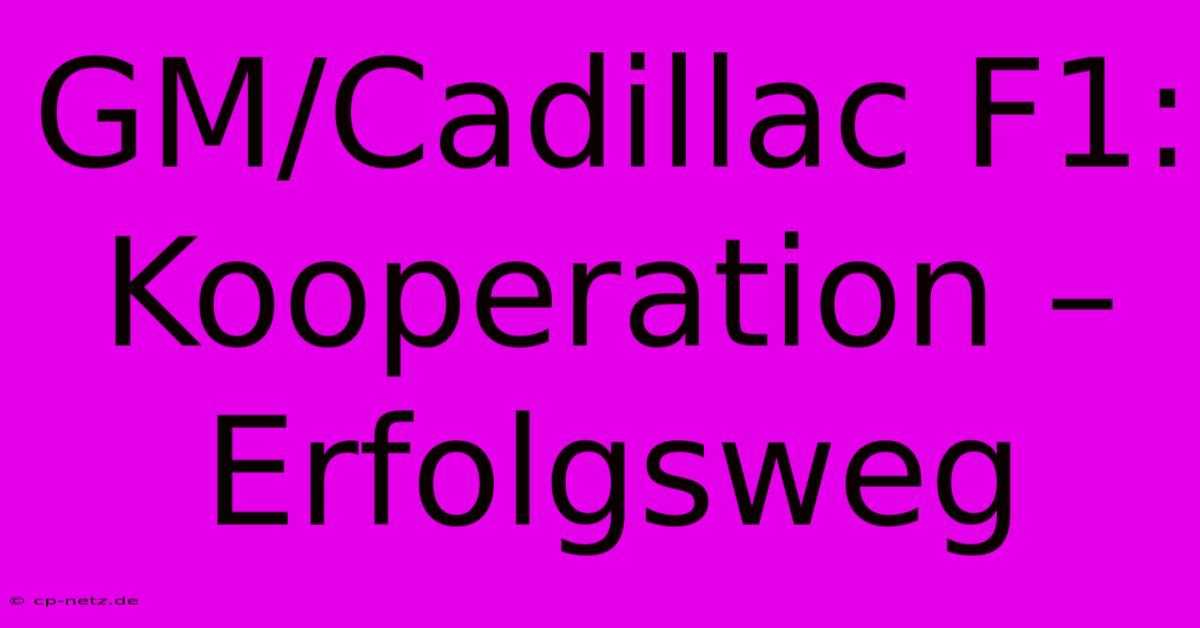GM/Cadillac F1: Kooperation – Erfolgsweg

Discover more detailed and exciting information on our website. Click the link below to start your adventure: Visit Best Website GM/Cadillac F1: Kooperation – Erfolgsweg. Don't miss out!
Table of Contents
GM/Cadillac F1: Kooperation – Erfolgsweg
Hey Leute! Let's talk about something kinda cool – the GM/Cadillac F1 partnership, or rather, the lack thereof, and why that's actually a pretty interesting case study in business strategy. I mean, imagine a Cadillac roaring down the track at the Monaco Grand Prix… sounds awesome, right? Well, it almost happened, but didn't quite work out that way. This isn't some super-secret conspiracy theory, just a fascinating look at how partnerships don't always go as planned, even with huge players involved.
Why a Cadillac F1 Car Never Happened (Spoiler Alert: It Didn't)
So, you're probably thinking, "Cadillac and F1? What gives?" Yeah, me too! It seemed like a natural fit, right? Cadillac, a brand with a legacy of powerful engines and sleek designs, teaming up with the pinnacle of motorsport... It’s a marketing dream. Huge brand recognition, potential for insane technological advancements, and a whole load of bragging rights. But alas, it never happened.
I remember reading about this a few years ago, and I was so bummed. I envisioned those iconic Cadillac tailfins gracing a Formula One car – the ultimate marriage of American muscle and European racing sophistication. Man, that would have been something!
The reality, however, is far less glamorous. While there were discussions and even some preliminary investigations, a full-blown partnership never materialized. There were likely several contributing factors, which we’ll explore. Maybe Cadillac felt the investment wouldn't generate enough return, or perhaps the branding complexities proved insurmountable.
Maybe the F1 regulations at the time presented insurmountable challenges for Cadillac's engineering team? Or maybe the whole thing just got lost in the shuffle of GM's broader strategic priorities. Honestly, some parts of this story are kinda shrouded in mystery.
The Importance of Strategic Alignment: A Lesson Learned
Looking back, this near-miss highlights the critical importance of strategic alignment in any kind of partnership, especially one as complex as a Formula 1 collaboration. It’s not just about throwing money at a problem; it’s about finding a synergistic relationship where both parties benefit significantly.
Think of it like this: Would a partnership between a luxury yacht manufacturer and a discount airline really work? Probably not. They cater to different customer segments and have wildly different brand images. Similarly, the Cadillac brand image, while strong, might not have been the perfect match for the high-octane, ultra-competitive world of F1. The target audiences, marketing strategies and overall brand values might have been too different.
What Could Have Been...and What We Can Learn From It
The potential benefits of such a collaboration were undeniably huge. Imagine the technological spillover! The engineering advancements made in F1 could've easily translated into improved Cadillac road cars, boosting performance and efficiency. And the marketing opportunities would have been insane.
But the lack of a partnership also teaches a valuable lesson: not every seemingly good idea is a good idea. Thorough due diligence, a clear understanding of each partner's goals, and a realistic assessment of the risks involved are absolutely essential. Rushing into a partnership without careful consideration can lead to wasted resources and damaged reputations. It's a lesson GM (and any other big company) could still benefit from learning again.
Key Takeaways: A Formula for Partnership Success
So, what's the takeaway here? For any business looking at collaborations, these points are KEY:
- Strategic Alignment: Make sure your partner's goals are aligned with yours.
- Due Diligence: Thoroughly investigate the partnership's potential benefits and risks.
- Realistic Expectations: Don’t expect miracles. Set achievable goals.
- Clear Communication: Maintain open and honest communication throughout the process.
This whole GM/Cadillac F1 thing? It’s a fascinating case study in how even the biggest players can miss a potential opportunity. But the missed opportunity teaches us a lot about the importance of strategic planning and realistic expectations. That’s something worth remembering, isn't it?

Thank you for visiting our website wich cover about GM/Cadillac F1: Kooperation – Erfolgsweg. We hope the information provided has been useful to you. Feel free to contact us if you have any questions or need further assistance. See you next time and dont miss to bookmark.
Featured Posts
-
Streit Bei Beamten Kv Verhandlungen Zaeh
Nov 26, 2024
-
Avignon Prozess Um Hoechststrafe Endet
Nov 26, 2024
-
Flugzeugabsturz Der Aktuelle Stand
Nov 26, 2024
-
Schuldenbremse Reform Merkels Wahlforderung 2025
Nov 26, 2024
-
Ps 5 Adventskalender 2024 Tag 1
Nov 26, 2024
